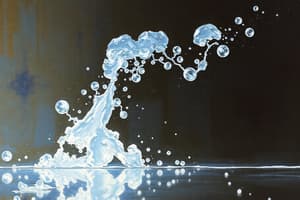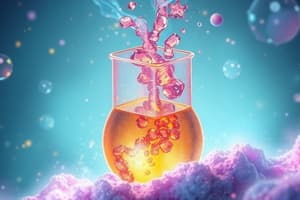Podcast
Questions and Answers
What characteristic do weak acids and bases share that affects their solubility?
What characteristic do weak acids and bases share that affects their solubility?
- Their solubility depends on the pH of the medium. (correct)
- They only dissolve in non-polar solvents.
- Their solubility does not vary with temperature.
- They are soluble in all solvents.
What is the relationship described by Henry's Law?
What is the relationship described by Henry's Law?
- Decreased pressure increases gas solubility.
- Increased pressure increases gas solubility. (correct)
- Increased temperature decreases gas solubility.
- Gas solubility is independent of pressure.
How can the solubility of a substance be enhanced according to the content?
How can the solubility of a substance be enhanced according to the content?
- By reducing the temperature of the solution.
- By adding more non-polar solute.
- By increasing the solvent's polarity.
- By manipulating the pH of the solution. (correct)
What does 'like dissolves like' mean in the context of solubility?
What does 'like dissolves like' mean in the context of solubility?
What is a saturated solution?
What is a saturated solution?
How does particle size affect solubility?
How does particle size affect solubility?
What defines the solubility of a substance?
What defines the solubility of a substance?
Which of the following contributes to a solution being classified as unsaturated?
Which of the following contributes to a solution being classified as unsaturated?
What is the definition of solubility in physical pharmacy?
What is the definition of solubility in physical pharmacy?
Which component dissolves the solute in a solution?
Which component dissolves the solute in a solution?
What characterizes a saturated solution?
What characterizes a saturated solution?
What is a supersaturated solution?
What is a supersaturated solution?
In drug formulation, why is understanding solubility important?
In drug formulation, why is understanding solubility important?
What does the Noyes-Whitney equation describe?
What does the Noyes-Whitney equation describe?
What is the formula for solubility?
What is the formula for solubility?
Which statement is true regarding the role of water in pharmaceutical applications?
Which statement is true regarding the role of water in pharmaceutical applications?
What distinguishes colloidal particles in terms of size from coarse dispersions?
What distinguishes colloidal particles in terms of size from coarse dispersions?
Which of the following best describes the Faraday-Tyndall effect?
Which of the following best describes the Faraday-Tyndall effect?
What is a defining characteristic of amphiphilic colloids?
What is a defining characteristic of amphiphilic colloids?
Brownian motion in colloidal systems is observable under which condition?
Brownian motion in colloidal systems is observable under which condition?
Which of the following substances represents a true colloid?
Which of the following substances represents a true colloid?
How does diffusion in colloidal systems occur?
How does diffusion in colloidal systems occur?
What size range defines coarse dispersions?
What size range defines coarse dispersions?
What role does the solvent sheath play around colloidal particles?
What role does the solvent sheath play around colloidal particles?
What effect does temperature generally have on the solubility of most substances?
What effect does temperature generally have on the solubility of most substances?
What is a characteristic of molecular dispersion in a dispersed system?
What is a characteristic of molecular dispersion in a dispersed system?
How does the presence of salts generally affect the solubility of substances?
How does the presence of salts generally affect the solubility of substances?
Which statement is true regarding gases and temperature effects on solubility?
Which statement is true regarding gases and temperature effects on solubility?
What defines a lyophobic dispersion?
What defines a lyophobic dispersion?
Flashcards are hidden until you start studying
Study Notes
Equilibrium Solubility
- Equilibrium solubility can be altered by changing external conditions, such as temperature.
- Solutions with more solute than the equilibrium solubility are unstable.
- Cooling a solution typically leads to crystallization of excess solute.
Unsaturated Solutions
- These solutions contain less solute than the maximum amount that can dissolve at a given temperature.
- Additional solute can still dissolve in unsaturated solutions.
Factors Affecting Solubility
-
pH of Solutions:
- Many drugs are weak acids or bases; their solubility often depends on the pH of the medium.
- Ionized drugs are generally more soluble in aqueous environments than their unionized forms.
-
Nature of Solute and Solvent:
- The principle "Like dissolves like" applies; polar solutes dissolve in polar solvents, while non-polar solutes favor non-polar solvents.
-
Pressure:
- For gases, increased pressure boosts solubility, as described by Henry's Law.
-
Temperature:
- Usually, solubility increases with temperature, except for gases, where it commonly decreases.
-
Particle Size:
- Smaller particles have larger surface areas which can enhance dissolution rates and solubility.
-
Presence of Salts:
- Salting Out: Presence of salts can decrease solubility.
- Salting In: Inclusion of salts can occasionally enhance solubility.
Types of Solutions
-
Saturated Solutions:
- No additional solute can dissolve at specific temperature and pressure. Represents the maximum solute concentration.
-
Supersaturated Solutions:
- Contains more solute than what can typically dissolve; these are metastable and can precipitate excess solute.
Components of Solutions
-
Solute:
- The substance that is dissolved (e.g., drugs, salts).
-
Solvent:
- The medium that dissolves the solute (commonly water in pharmaceuticals due to biocompatibility).
Dissolution
- Describes the transfer of molecules from a solid state into solution, often evaluated through the Noyes-Whitney Equation.
Classifications of Dispersed Systems
-
Molecular Dispersion (True Solutions):
- Composed of components with particle sizes less than 1 nm (e.g., oxygen, glucose).
-
Colloidal Dispersion:
- Intermediate particle size (1 nm to 0.5 μm), examples include colloidal silver.
-
Coarse Dispersion:
- Larger particles (>0.5 μm) such as grains of sand and red blood cells.
Properties of Colloids
-
Optical Properties:
- Exhibit the Faraday-Tyndall Effect, scattering light and altering its polarization.
-
Kinetic Properties:
- Show Brownian motion where colloidal particles move continuously, demonstrating diffusion until equilibrium is achieved.
Studying That Suits You
Use AI to generate personalized quizzes and flashcards to suit your learning preferences.




